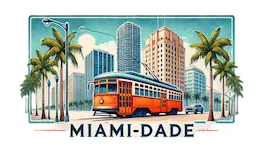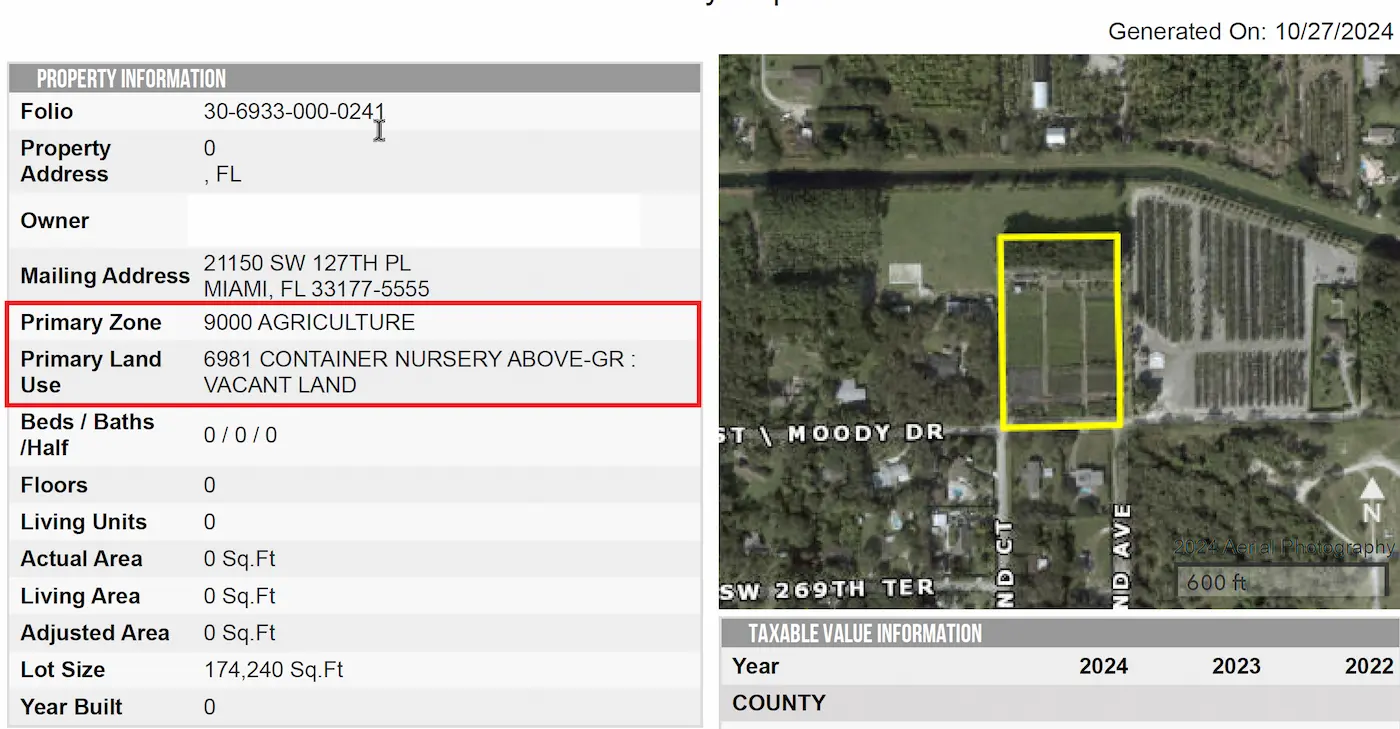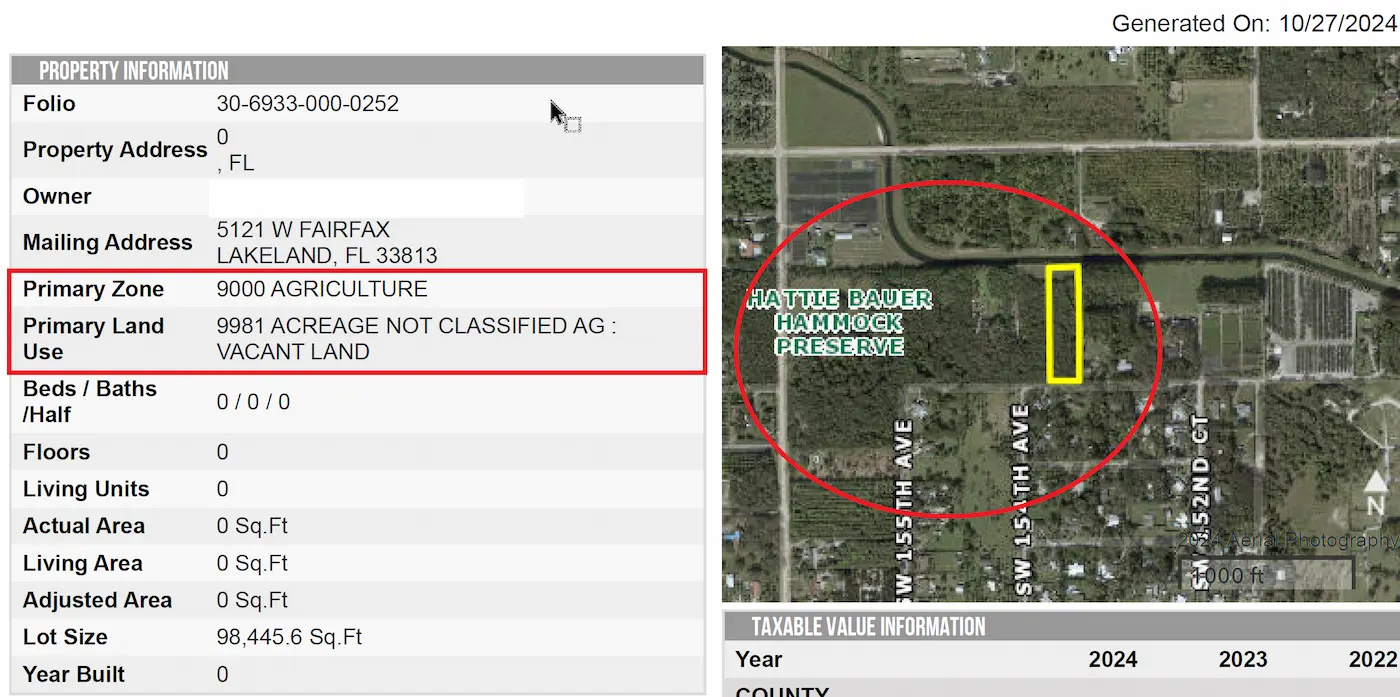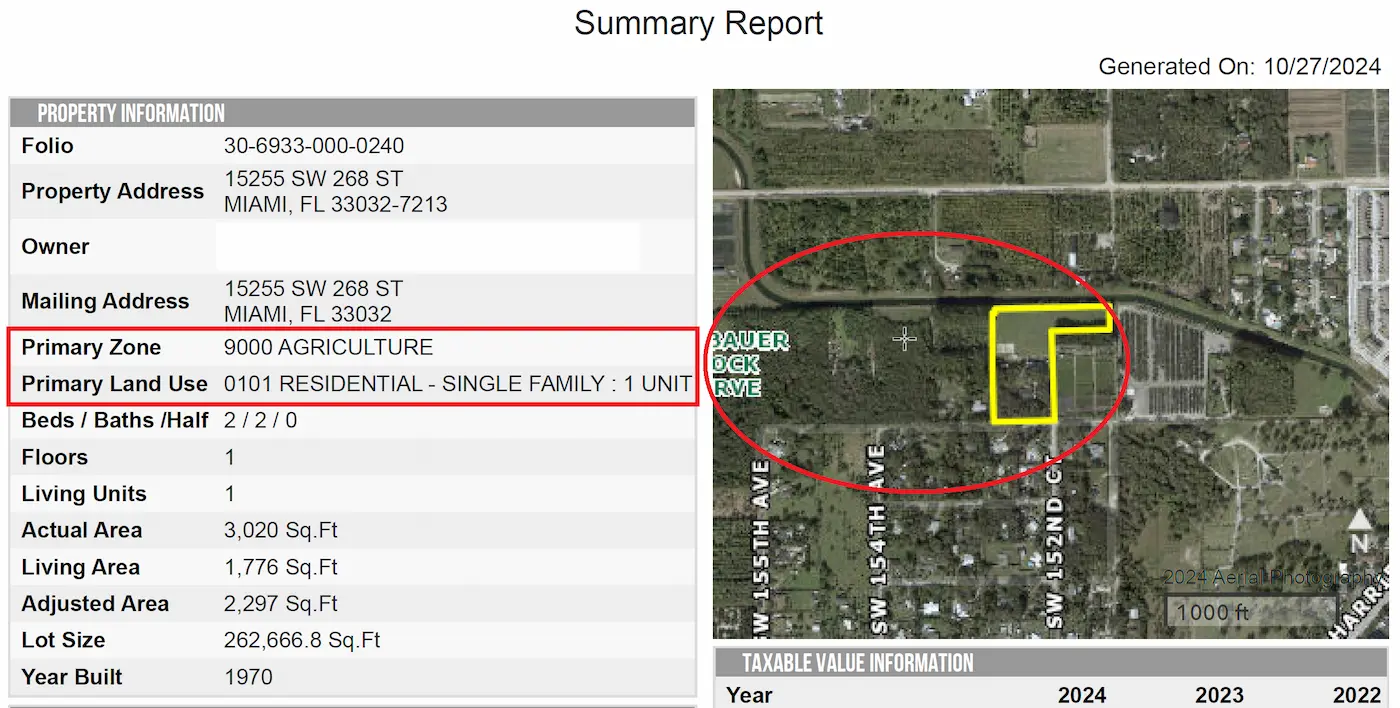|
Getting your Trinity Audio player ready... |
Tabla de Contenido/ Table of Contents
- 1 The Urgent Fight to Save Miami-Dade’s Last Green Frontier by 2025: Redland. Cement vs. Nature and Rural Life, Agricultural Land.
- 1.1 🔺 Introduction to the conflict:
- 1.2 🌿 Axis 1: Severe Environmental Impact and Biodiversity Loss
- 1.2.1 I. RISK STATEMENT
- 1.2.2 II. POSSIBLY INVOLVED SPECIES
- 1.2.3 III. VIOLATION OF CONSERVATION POLICIES
- 1.2.4 🐾 Axis 2: Direct Risk to Protected Species and Rural Fauna
- 1.2.5 II. SPECIES AT POTENTIAL RISK IN THE AREA
- 1.2.6 III. IMMEDIATE ECOLOGICAL EFFECTS OF THE DEVELOPMENT
- 1.2.7 IV. LEGAL OBLIGATIONS INVOLVED
- 1.2.8 V. AGGRAVATING SITUATION: PROXIMITY TO PRESERVATION AREAS
- 1.3 🔒 Axis 3: What is Bluenest really doing?
- 1.3.1 🔒 I. Is Miami-Dade County fulfilling its duty to protect agricultural lands, rural areas, and sensitive habitats?
- 1.3.2 ⚠️ II. WHAT IS BLUENEST DOING?
- 1.3.3 🧬 V. THE CHANGE IS IRREVERSIBLE
- 1.3.4 🛠️ VI. THE FALSE “URBAN NEED”
- 1.3.5 🧨 VII. WHAT RISK DOES THIS APPROVAL OPEN?
- 1.3.6 🛠️ VI. THE FALSE “URBAN NEED”
- 1.3.7 🧨 VII. WHAT RISK DOES THIS APPROVAL OPEN?
- 1.4 💧 AXIS 4 – POLLUTION, AQUIFERS, WELLS AND RISK TO THE AREA’S WATER SYSTEM
- 1.5 🚨 AXIS 5 – PRESSURE ON PUBLIC INFRASTRUCTURE
- 1.5.1 🏗️ I. GENERAL INTRODUCTION
- 1.5.2 🚗 II. TRAFFIC AND MOBILITY: COLLAPSE IN NORMAL AND EMERGENCY TIMES
- 1.5.3 🧑🏫 III. EDUCATION: INSUFFICIENT AND OVERCROWDED SCHOOLS
- 1.5.4 🏥 IV. HEALTH, SAFETY AND EMERGENCY SERVICES
- 1.5.5 💩 V. DRINKING WATER, SEWER AND WASTE
- 1.5.6 📜 VI. LEGAL BASIS AND PLANNING
- 1.5.7 📣 VII. COMMUNITY VOICES
- 1.6 ⚖️ AXIS 6 – LEGALITY, CDMP VIOLATION AND POLITICAL FAVORITISM
- 1.7 🧾 CONSOLIDATED REPORT: CURRENT STATUS OF THE BLUENEST – NARANJA REZONING DOSSIER
- 1.8 👩💼 Key Role of Authorities
- 1.9 Public Opinions on the Bluenest Naranja Case (CDMP2024-0016)
- 1.9.1 🌳 Defense of unique ecosystems
- 1.9.2 🚧 Traffic collapse and pressure on infrastructure
- 1.9.3 🗣️ Allegations of lack of transparency and political favoritism
- 1.9.4 🧭 Call to explore responsible alternatives
- 1.9.5 📢 Emotional closure and citizen call
- 1.9.6 📣 COMMUNITY TESTIMONIES AND CITIZEN EVIDENCE
- 1.10 🧭 AXIS 7: Cultural Impact and Destruction of Rural Way of Life in Naranja and the Redlands
- 1.10.1 I.🏡 A community with agricultural, historical and ecological identity
- 1.10.2 II. 🚫 Uncontrolled urbanization vs. rural values
- 1.10.3 III. 📉 Silent gentrification and cultural displacement
- 1.10.4 IV. 📜 Violation of the principle of preserving the “character of place”
- 1.10.5 V. 🧑🌾 Local testimonies and active cultural opposition
- 1.11 AXIS 8: Alternative Proposal and Responsible Location
- 1.12 🔴 Key Evidence and Complaints
- 1.13 🔊 Community Call
The Urgent Fight to Save Miami-Dade’s Last Green Frontier by 2025: Redland. Cement vs. Nature and Rural Life, Agricultural Land.
🔺 Introduction to the conflict:
The south of Miami-Dade County faces a critical threat: the proposal from developer Bluenest Development LLC (CDMP2024-16 / Z2024-242) to transform 33.14 acres of agricultural land into a development of 500 townhouses in the rural area of Naranja. This project implies breaking the agricultural zoning code (AU) to convert it into multifamily residential (RU-TH), generating severe ecological, cultural, and social consequences.
PROJECT IDENTIFICATION AND DESCRIPTION
Project name: Bluenest Naranja
Ongoing process: Zoning Hearing Application No. Z2024-242 and CDMP Amendment CDMP2024-16
Proposal: Change land use from agricultural (AU) to multifamily residential (RU-3M / RU-TH) to build 500 townhouses
Location: North of SW 268 St and east of SW 154 Ave
Land: 33.14 acres (with multiple private owners listed in the letter of intent)
Intended development: “Workforce housing” with supposedly 20% affordable
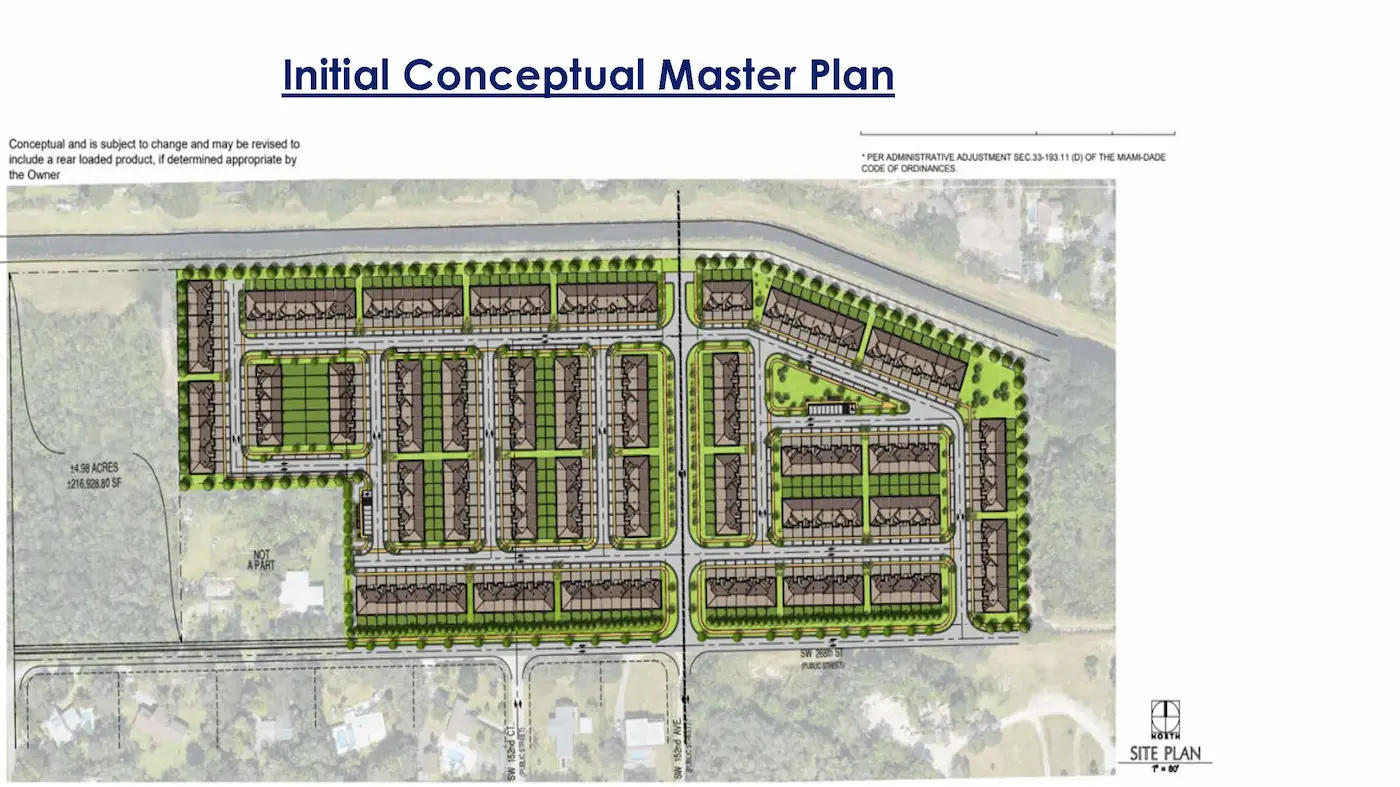
🌿 Axis 1: Severe Environmental Impact and Biodiversity Loss
The land proposed for urbanization hosts a sensitive ecosystem, including subtropical tropical forests and unique geological formations like “solution holes” that connect directly to the Biscayne Aquifer, a vital source of drinking water. A recent review identified protected species such as:
Venus Fern (Adiantum tenerum)
Sawgrass Fern (Blechnum serrulatum)
Thelypteris interrupta Fern These ferns and other plant species do not survive removal and alteration of the soil, contradicting relocation promises from the developer.
I. RISK STATEMENT
The agricultural rezoning project led by Bluenest Development LLC, identified as CDMP2024-16 / Z2024-242, threatens to destroy a sensitive ecosystem that harbors native plant species listed as protected by the State of Florida.
II. POSSIBLY INVOLVED SPECIES
The ferns identified in the images morphologically correspond to species that have been listed as threatened by the Florida Department of Agriculture & Consumer Services (FDACS) and require active protection:
Adiantum tenerum (Venus Fern, threatened)
Blechnum serrulatum (Sawgrass Fern, wetland habitat endangered by urbanization)
Thelypteris interrupta (sensitive to soil and water changes)
These species do not survive soil removal or drainage alteration processes, which invalidates any attempt at “relocation” and contradicts the idea that these areas will not be affected.

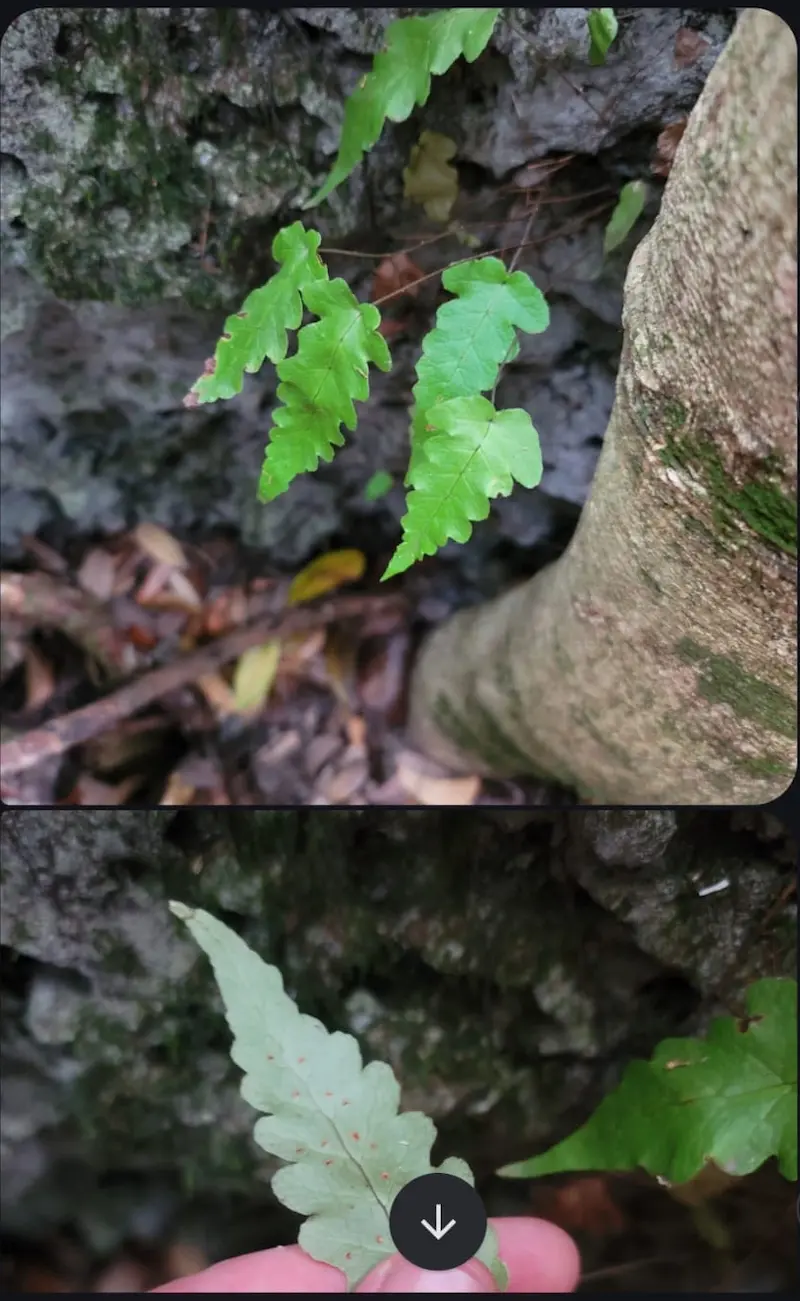
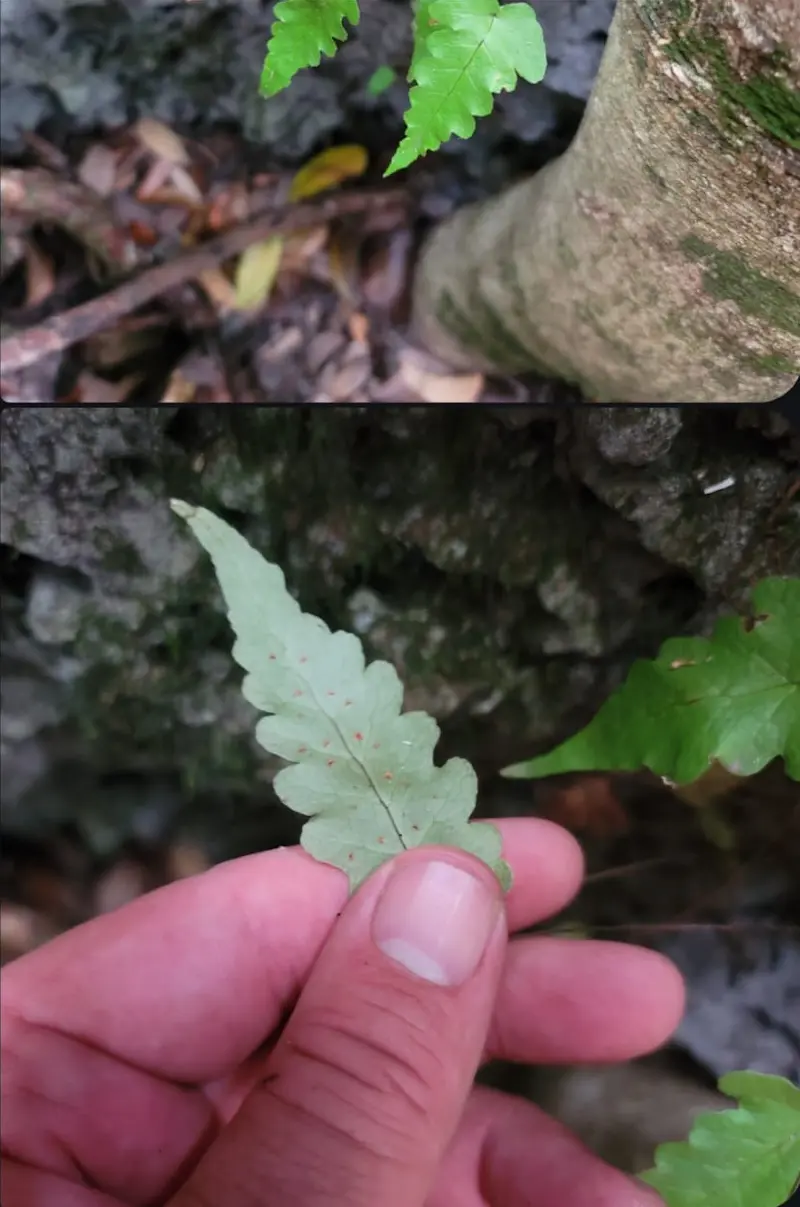
III. VIOLATION OF CONSERVATION POLICIES
The presence of listed species obligates the County to:
Conduct a formal environmental study (Phase I ESA) before continuing the rezoning process.
Apply Section 24-49 of the County Code, which prohibits removal or alteration activities of habitats of listed species.
Suspend the voting process until compliance is guaranteed with:
Florida Endangered and Threatened Species Rule (Chapter 5B-40 FAC)
Federal Endangered Species Act (1973) if any of the species are federally protected.
🐾 Axis 2: Direct Risk to Protected Species and Rural Fauna
The Bluenest project in Naranja aims to develop in an ecologically sensitive area, bordering or overlapping wildlife corridors and critical habitats for various protected species. The urbanization of 500 townhouses will fragment the ecosystem, interrupt migration, feeding and breeding routes, and directly endanger fauna classified as vulnerable, threatened or endangered.
II. SPECIES AT POTENTIAL RISK IN THE AREA
📍 Analyzed location: Parcel between SW 268th St and SW 154th Ave, north of the C-103 canal.
📚 Sources: FWC, FDACS, USFWS maps, and local testimony.
🦉 1. Burrowing Owl (Athene cunicularia floridana)
Status: Threatened species in Florida.
Habitat: Open areas, soft soils, grasslands without construction.
Risk: Machinery and soil compaction destroy active burrows, causing direct mortality and forced displacement.
🐍 2. Eastern Indigo Snake (Drymarchon couperi)
Status: Federally protected (U.S. Endangered Species Act).
Habitat: Dry environments, agricultural, forest edges.
Risk: Urbanization of this area violates federal regulations if not previously surveyed with documented negative presence.
🦇 3. Florida Bonneted Bat (Eumops floridanus)
Status: Critically Endangered (federal and state).
Habitat: Agricultural areas, forest edges, open structures.
Risk: Noise, artificial lighting and loss of refuge compromise its already limited population (less than 1,000 estimated).
🐸 4. Green Treefrog, Florida Leopard Frog and other amphibians
Highly sensitive to drainage, fertilizers and removal of riparian vegetation.
Key part of pest control in agricultural areas.
Urbanization unbalances the food ecosystem.
🦋 5. Rare native butterflies (Zarucco Duskywing, Bartram’s Scrub-hairstreak)
Already disappeared from many Miami-Dade habitats.
Require specific native vegetation that would be destroyed by the project.
In addition to protected flora, typical rural ecosystem fauna is documented:
Such as horses, cows, chickens, and other farm animals, would lose their natural spaces and traditional rural habitats, jeopardizing the way of life of farming families.
A post shared by SaltyBrood Jose Debasa (@the_saltybrood)
III. IMMEDIATE ECOLOGICAL EFFECTS OF THE DEVELOPMENT
Fragmentation of natural habitats (interrupting ecological corridors).
Noise, lighting, traffic and machinery movement incompatible with sensitive fauna.
Elimination of nesting, hunting and breeding areas.
Leakage of gray water and chemicals into the C-103 canal and its associated vegetation.
Vehicle collisions with displaced fauna as vehicular traffic increases (more than 1,000 vehicles estimated).
IV. LEGAL OBLIGATIONS INVOLVED
The county and the developer could be in violation of multiple state and federal regulations if they proceed without the corresponding studies:
🛑 U.S. Endangered Species Act (federal protection for indigo snake and bonneted bat).
🛑 Chapter 68A-27 F.A.C. (Florida Administrative Code on threatened species).
🛑 CDMP Policy CON-7G: “Miami-Dade County shall ensure that development adjacent to or near sensitive habitats shall minimize impact on native wildlife.”
🛑 Miami-Dade Code Sec. 24-49: Prohibits developments that affect protected species or critical habitats without express authorization.
V. AGGRAVATING SITUATION: PROXIMITY TO PRESERVATION AREAS
The land is less than 150 meters from Hattie Bauer Hammock, recognized as a subtropical tropical forest ecosystem.
Neighboring South Dade Palms Memorial Cemetery and other undeveloped lands that serve as ecological buffer zones.
This area acts as a biological buffer zone between the agricultural and urban corridors. Its alteration would cause a gradual collapse in the ecological chain.
A post shared by SaltyBrood Jose Debasa (@the_saltybrood)
🔒 Axis 3: What is Bluenest really doing?
🔒 I. Is Miami-Dade County fulfilling its duty to protect agricultural lands, rural areas, and sensitive habitats?
Miami-Dade County’s obligation is clear: to protect agricultural lands, rural areas, and ecological habitats from uncontrolled urban expansion. However, the reality is different:
It does not stop the destruction of the agricultural belt in the south of the county.
It does not preserve natural habitats, nor does it prevent ecological fragmentation by approving projects like this one.
It ignores that a population increase in the area creates unsustainable pressure on public infrastructure: water, sewage, schools, and basic services.
It forgets that its main function should be the protection of coastal areas and underground aquifers from contamination.
These areas should be safeguarded by firm and coherent policies included in the CDMP (Comprehensive Development Master Plan). But in practice, the county is not fulfilling that responsibility.
⚠️ II. WHAT IS BLUENEST DOING?
Bluenest Development LLC is requesting:
- through case CDMP20240016.
- To rezone 33.14 acres of agricultural land (case Z2024000242).
- To transform the protected area to build 500 townhouses.
This is not just an isolated rezoning; it is a reconfiguration of the legal boundary that protects the environmental and agricultural balance of the county’s south.
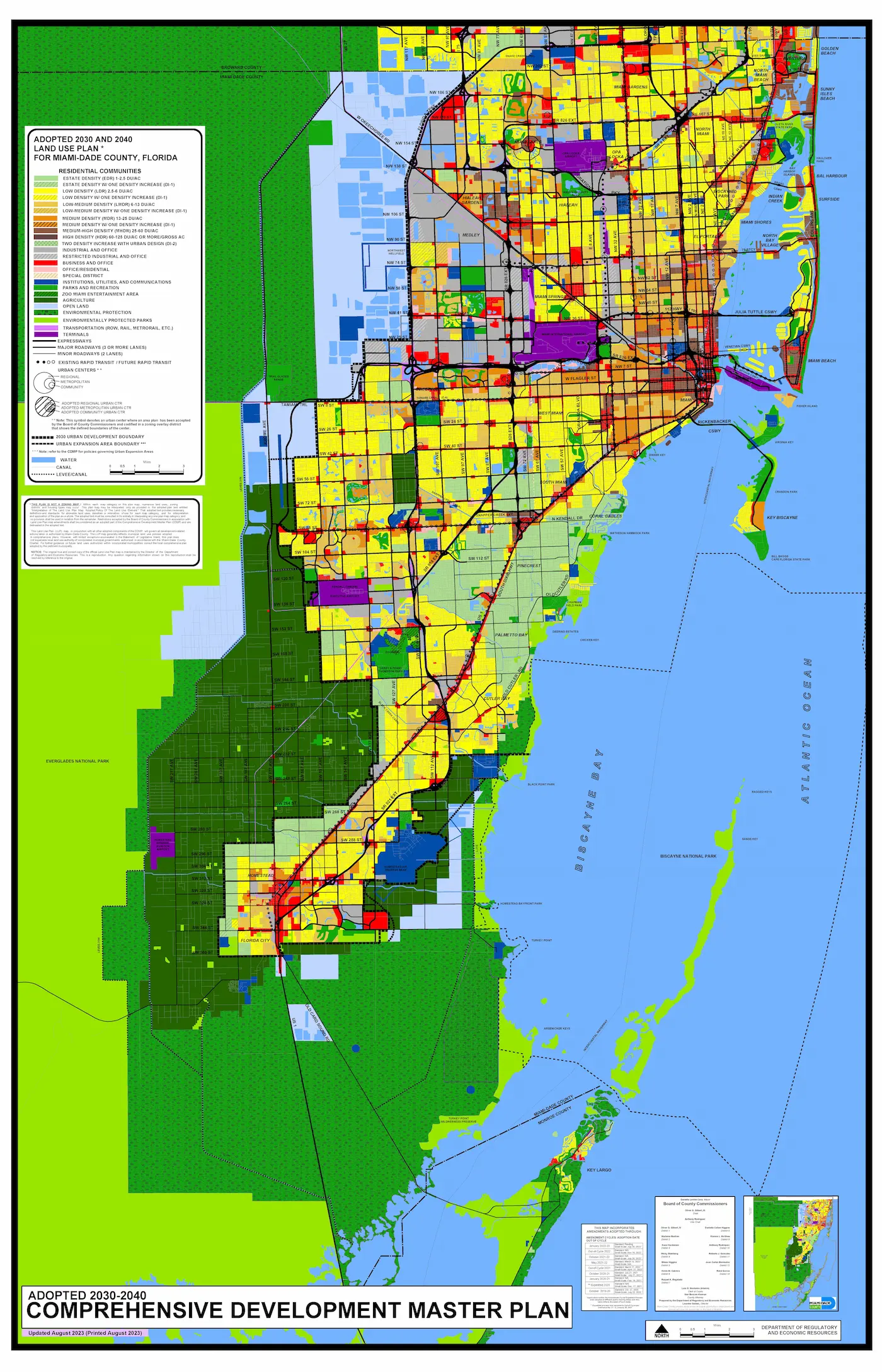
This is the adopted land use map for Miami-Dade, 2030-2040.
The stated purpose of this Comprehensive Development Master Plan is to protect the lands and ecosystem of our county, implement less expansive strategies, and give existing cities the power to regenerate, to rise again from the abandonment caused by the county’s own neglect.
The real priority should be to restructure and revive those neighborhoods that are today crying out to be redeveloped: vulnerable neighborhoods, full of abandoned structures and underutilized lands, which can become safe, dignified, and welcoming environments for thousands of families.
Instead of continuing to extend cement into the few green areas that remain, we must look inward: reuse, rehabilitate, and transform what we already have.
Neighborhoods like Liberty City, Overtown, Brownsville, Little Haiti, Allapattah, Goulds, Homestead, and parts of Opa-locka and North Miami have been historically neglected and need a real urban renewal push. There are vacant lots and unused buildings there that can be the foundation for affordable housing projects and community spaces. It makes no sense to destroy animal habitats or unique ecosystems just to give business to a handful of developers.
We must leave green lands for future generations, because what we don’t take care of today will only remain in history books and old postcards tomorrow. It’s time to think about rehabilitating cities, not expanding into nature, as has happened again and again in Miami-Dade.
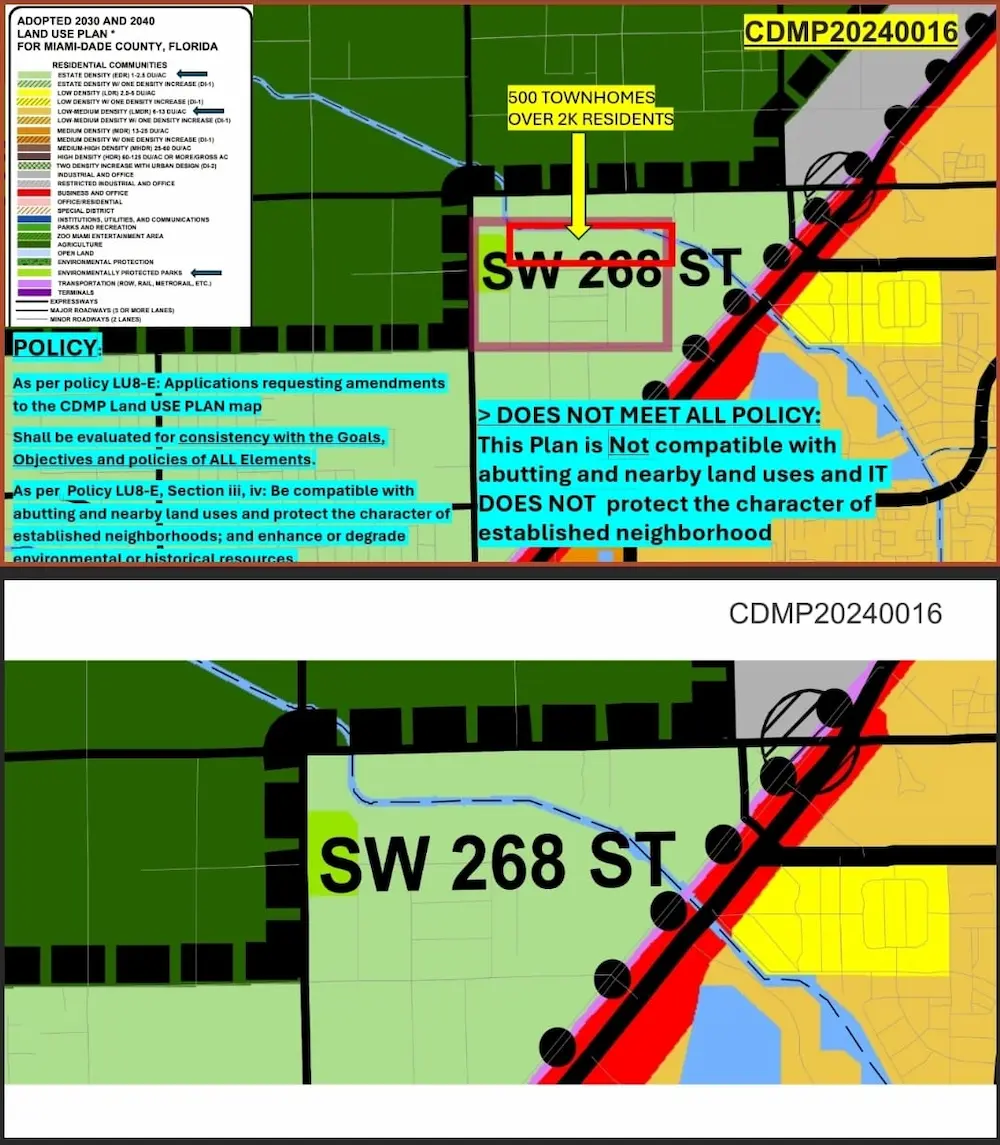
🧬 V. THE CHANGE IS IRREVERSIBLE
Modifying the rural environment has consequences:
The land goes from protected rural zone to urban use forever.
The impact is permanent: traffic, pollution, habitat loss, pressure on services, disappearance of local agriculture.
🚫 The county does not have established mechanisms to reverse these decisions if they result in negative effects in the future. Once the door is opened, other agricultural lands in Redland, Goulds, Princeton, and Naranja will come under speculative pressure.
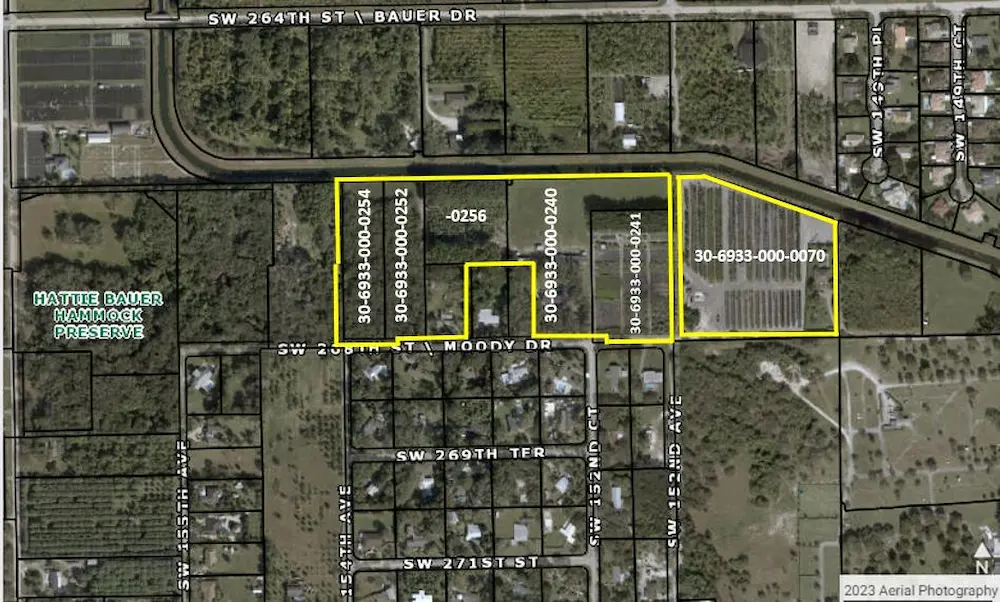
🛠️ VI. THE FALSE “URBAN NEED”
Bluenest argues that more housing is needed for the population. But:
- Their townhouses are not affordable nor do they address social housing or workforce housing needs.
- They are designed for upper-middle classes, with no real housing solution offered.
- The true purpose is to turn cheap land into quick profit for investors.
🧨 VII. WHAT RISK DOES THIS APPROVAL OPEN?
- Collapse of the county’s planning system.
- Destruction of the agricultural belt in the south of the county.
- Public distrust in public processes.
- Possible lawsuits for violation of the CDMP and administrative arbitrariness.
- Irreversible loss of credibility for the Commission and the Planning Office.
🛠️ VI. THE FALSE “URBAN NEED”
Bluenest argues that more housing is needed for the population. But:
Their townhouses are not affordable nor do they address social or workforce housing needs.
They are designed for upper-middle classes, without any contribution to housing solutions.
The true purpose is to transform cheap land into quick profit for investors.
🧨 VII. WHAT RISK DOES THIS APPROVAL OPEN?
Collapse of the county’s planning system.
Destruction of the southern county’s agricultural belt.
Public distrust in public processes.
Possible lawsuits for violation of the CDMP and administrative arbitrariness.
Irreversible loss of credibility of the Commission and Planning Office.
💧 AXIS 4 – POLLUTION, AQUIFERS, WELLS AND RISK TO THE AREA’S WATER SYSTEM
🧭 I. WATER CONTEXT IN THE NARANJA / REDLAND AREA
The region where Bluenest proposes to build sits on permeable, limestone land, with “solution holes,” karstic formations that connect directly to:
The Biscayne Aquifer, the main source of drinking water for over 2 million people in South Florida.
Artisan and community pumping wells used by rural residents of Redland and Naranja.
Agricultural drainage systems and canals that discharge into Biscayne Bay, an ecosystem already at risk from excess nutrients and pollutants.
⚠️ II. WATER IMPACTS FROM THE DEVELOPMENT OF 500 TOWNHOUSES
The massive construction of the Bluenest project will generate:
- 1. Alteration of natural runoff
By replacing absorbent soil with concrete and asphalt, surface runoff increases.
Higher risk of local flooding and overflow during storms, especially in a hurricane evacuation zone and during extreme weather events.
2. Pollution of the rear canal and the aquifer
Wastewater, vehicle oils, ornamental fertilizers and urban waste will flow into the adjoining canal.
That canal drains directly into Biscayne Bay, and feeds the local aquifer.
It will break the natural balance of the hydrological cycle, affecting clean recharge of the aquifer.
3. Crisis for rural wells
Many area residents still use private wells for their supply.
The concentration of more than 2,000 new residents in 33 acres may cause over-extraction or contamination from gray and black water infiltration.
🧪 III. DIRECT ENVIRONMENTAL RISK FACTORS
| Factor | Description of risk |
|---|---|
| 🧱 Soil waterproofing | Loss of natural filtering capacity of agricultural soil |
| 🧫 Black and gray water | Possible leaks through limestone to the aquifer |
| 🛻 Urban toxins | Oils, heavy metals, detergents, pesticides |
| 💧 Rear canal | Without containment barriers, it will receive all contaminated runoff |
| 🔥 Flooding | Increased risk of flooding from storms and hurricanes |
| 🐠 Biscayne Bay | Risk of eutrophication from urban nutrients and pollutants |
📜 IV. RELEVANT LAWS AND PROGRAMS
Clean Water Act (CWA) – Federal
Prohibits discharge of pollutants without permits into navigable waters, including systems connected to aquifers.
Biscayne Aquifer Protection Program (South Florida Water Management District)
Establishes measures to restrict high-density developments over recharge areas.
Florida Statutes Chapter 373
Regulates extraction and use of water, requiring impact studies when there is risk to public health or resource sustainability.
🔍 V. KEY SIGNS IN THE BLUENEST CASE
Bluenest did not submit independent, verifiable water studies.
No runoff modeling or analysis of the impact on community wells was included.
There are no mitigations against contaminant infiltration, which is serious on porous stone terrain.
The rear canal lacks retention or natural filtration infrastructure, exposing Biscayne Bay.
📣 VI. COMMUNITY TESTIMONIES AND CITIZEN EVIDENCE
“The runoff from that development will end up in the canal behind the land, adding more contaminants to the water that goes straight to our water source.”
— Save The Redland Petition
“Every storm already floods our parcels. If they raise that land by 2 or 3 feet to urbanize, we’ll live with water at our door.”
— Valentina Delcoro, area neighbor
🚨 AXIS 5 – PRESSURE ON PUBLIC INFRASTRUCTURE
🏗️ I. GENERAL INTRODUCTION
The rezoning plan CDMP2024-16 / Z2024-242 proposed by Bluenest to urbanize over 33 agricultural acres in Naranja and install 500 townhouses that would house over 2,000 new residents, places an unsustainable burden on the area’s already fragile public infrastructure.
If approved, this development will cause a public services crisis in traffic, schools, health, safety, transport, drinking water, sewage and waste collection.
🚗 II. TRAFFIC AND MOBILITY: COLLAPSE IN NORMAL AND EMERGENCY TIMES
🚧 Limited road access:
The proposed land has only one entry and exit route: SW 268 St → SW 152 Ct → SW 272 St.
The rear canal prevents opening alternative routes.
All traffic would pour into already congested corridors: SW 268 St and SW 272 St.
🚨 In case of evacuation:
The area is in a nuclear and hurricane evacuation zone.
With 2,000 new residents, a single escape route becomes a death trap in case of fire, storms or accidents.
The recent Overseas Highway fire case demonstrates the road vulnerability of single-entry areas.
🧑🏫 III. EDUCATION: INSUFFICIENT AND OVERCROWDED SCHOOLS
❌ Current deficit:
Area schools are already at or above critical capacity.
No new schools are projected for this sector according to the county School Board.
🚌 Direct consequences:
Approximate estimate: 300-400 new children.
Current parents report trips of up to 40 minutes daily north to find decent schools.
📉 Effect on educational quality:
More students without proportional increase in staff or facilities = quality drop.
Local students displaced by external density.
🏥 IV. HEALTH, SAFETY AND EMERGENCY SERVICES
🚑 Medical services:
No hospital or primary clinic nearby.
Ambulance response can take up to 25 minutes under normal conditions.
🚓 Public safety:
Crime increase in the area already recorded by neighbors:
Home robberies, shootings, pet poisonings and exotic animal theft (300 parrots).
The nearest station lacks resources to cover an increased population without a budget increase.
🚒 Fire services:
The area is surrounded by dry vegetation and is vulnerable to wildfires.
There are not enough hydrants or fire stations within 3 miles.
💩 V. DRINKING WATER, SEWER AND WASTE
🚱 Unplanned infrastructure:
The plan requires extending water lines from SW 272 St to 154 Ave and then east to 268 St.
Forced works would cross private properties, causing protests and additional costs to the county.
💧 Risks:
Increased water consumption without increasing pumping capacity.
Increased wastewater without new treatment plants in the immediate area.
🗑️ Waste collection:
There is no approved logistics plan or additional funding for garbage, recycling or debris collection.
📜 VI. LEGAL BASIS AND PLANNING
The CDMP (Comprehensive Development Master Plan) requires that any rezoning be compatible with the capacity of existing or planned public infrastructure.
This project does not meet compatibility and adequacy criteria.
“Urban expansion can only be considered if public services are adequate and sustainable.”
— Article 3.2.1 of the Miami-Dade CDMP
📣 VII. COMMUNITY VOICES
“We have no streets to evacuate in a hurricane. If you approve this, you condemn us.”
— Mercy Pérez, signer of the Save The Redland petition
“My son’s school is already crowded. What’s going to happen with 300 more kids?”
— Valentina Delcoro, local resident
“Who picks up the garbage for 2,000 more people if now they only come once a week?”
— Robert Redding, local farmer
⚖️ AXIS 6 – LEGALITY, CDMP VIOLATION AND POLITICAL FAVORITISM
The rezoning project proposed by Bluenest, which seeks to transform over 33 agricultural acres in Naranja to build 500 townhouses, contravenes multiple legal and regulatory principles of the Miami-Dade Comprehensive Development Master Plan (CDMP). Additionally, the process shows clear signs of privileged treatment and political collusion in favor of the developer, to the detriment of the common good and public interest.
📜 I. MAIN CDMP PRINCIPLES VIOLATED
- 1. Violation of the Principle of Land Use Compatibility
“Zoning changes must be compatible with current land use, adjacent rural or agricultural context, and environmental characteristics of the area.” — CDMP, Land Use Element, Section 2.1
The project proposes introducing high urban density (RU-TH) in a historically agricultural area with 1-acre parceling per home.
It is an aggressive urban invasion, not an organic or harmonious expansion.
2. Contradiction with the Principle of Environmental Sustainability
“Land use changes must not compromise the viability of natural resources or biodiversity.” — CDMP, Conservation Element
The request directly endangers habitats of protected species (owls, hawks, bonneted bat, listed ferns), millennia-old sinkhole geologic solutions, and proximity to lands under EEL Program protection (Environmentally Endangered Lands).
3. Disconnection with the Infrastructure Master Plan
“All approved development must have planned and budgeted public services.” — CDMP, Public Services Element
There is no realistic projection of drinking water, drainage, waste collection, or school and public safety capacity.
4. Noncompliance with the Administrative Ethics Code
“All rezoning requests must be evaluated equally, without preferential treatment to any private actor.” — Miami-Dade Public Administration Ethics Code
🧾 II. DETECTED INCONSISTENCIES AND PREFERENTIAL TREATMENT
✅ 1. Speeding up administrative procedures
Bluenest’s Letter of Intent (June 2025) was accepted and scheduled for a vote in unusually fast deadlines, suggesting internal pressure or preferential treatment.
✅ 2. Possible connection with political actors
The political donation history or business ties of Bluenest Development LLC has not been made public and must be thoroughly investigated.
Lack of transparency about final owners and real project beneficiaries is serious.
✅ 3. Lack of required studies
Dossier Z2024-242 does not include road capacity studies, deep environmental impact analysis, or consultation with the EEL Advisory Committee, which should be grounds for procedural nullity.
✅ 4. Noncompliance with participatory processes
The local community has denounced:
Lack of effective consultation with residents.
Limited time allocation to speak (1 minute).
Sessions at times and in formats that are not accessible.
Ignoring community requests such as that of Save The Redland.
🏛️ III. LEGAL PRECEDENTS AND RISKS
🛑 Dangerous Precedents:
Approving this case would open the door to 20+ similar requests in agricultural areas within the county.
Sets a precedent for the UDB (Urban Development Boundary) to lose validity as a tool for containing chaotic development.
⚠️ Possible Legal Implications:
Lawsuits for:
CDMP violation.
Irregular administrative procedure.
Environmental impact without evaluation (violation of NEPA if federal funds are involved).
Approval without valid community consultation (violation of the Sunshine Law).
🧾 CONSOLIDATED REPORT: CURRENT STATUS OF THE BLUENEST – NARANJA REZONING DOSSIER
📌 PROJECT DATA SHEET
Project Name: Not specified (provisionally identified by its dossier)
Location: North of SW 268 Street, east of SW 154 Avenue, on both sides of SW 152 Avenue, Naranja, Miami-Dade, FL
Land size: 33.14 acres
Proposed residential units: 390 (all classified as Single Family Detached)
Affordable housing: ❌ Does not include Workforce Housing units
Type of request:
Zoning change from AU (Agricultural) to single-family residential zone
CDMP (Comprehensive Development Master Plan) amendment request
Requests District Boundary Change and Site Plan review
📊 PROCESS STATUS
🔧 Dossier progress: 65%
Total fee due: $6,492.36 → NOT PAID
📆 Scheduled Public Hearing
Date: July 17, 2025
Place: Stephen P. Clark Center, 111 NW 1st Street, 2nd floor
Time: 9:30 AM
📋 DETAILED STATUS OF THE APPROVAL FLOW
🔴 KEY AREAS NOT YET APPROVED (last review on June 23, 2025)
| Department / Review | Status | Last Action Date |
|---|---|---|
| RER – DERM (Environment) | 🟠 In Review | Scheduled: 09/06/25 |
| Police | ✅ Approved | 09/06/25 |
| Schools | ✅ Approved | 05/06/25 |
| Zoning PH | ✅ Approved | 18/06/25 |
| Platting & Traffic | ✅ Approved | 18/06/25 |
| Public Works – Traffic Engineering | ✅ Approved | 16/05/25 |
| MDTA (Transport) | ✅ Approved | 30/05/25 |
| Legal / Cadastral / Notices | ✅ Approved | 11/06/25 |
| RER – BNC | ✅ Approved | 03/06/25 |
🧨 However, the total history of the flow shows:
Over 20 prior rejections between December 2024 and May 2025.
Departments such as DERM, Zoning PH, Schools, Traffic and Police have required multiple correction rounds before reaching the current stage.
🧮 CRITICAL OBSERVATIONS
⚠️ 1. Rushed and Unstable Technical Approvals
Most key areas have been rejected in several rounds, including:
DERM (rejected at least 3 times)
Zoning PH
Schools
Traffic Engineering
📌 The record shows a forced intent to approve the project after multiple initial rejections, something that should be publicly highlighted as a sign of “initial institutional resistance” that was later overcome.
⚠️ 2. The Process Remains Open and the Environmental Component is NOT YET CLOSED
The RER – DERM review remains “In Review,” not having been marked as “completed” since 06/02/25.
This implies the dossier may still receive internal or public technical objections before moving to a vote.
⚠️ 3. Legal and Procedural Questions
The project requires changing the CDMP and the UDB (Urban Development Boundary), which by itself activates higher and non-automatic review criteria.
However, it has already been scheduled for public hearing on July 17, without the environmental dossier having been completed.
📍 INVOLVED FOLIOS
3069330000070
3069330000256
3069330000240
3069330000254
3069330000252
3069330000241
✅ UPDATED GENERAL CONCLUSION
The Bluenest project in Naranja:
Has been persistently rejected and corrected since December 2024.
Is pending only the final environmental report (DERM), which remains “In Review.”
Has already been scheduled for a county hearing on July 17, indicating an accelerated process even though the dossier is neither complete nor paid ($6,492.36).
The dossier is based on a CDMP amendment and UDB change, which implies major impact and requires greater public scrutiny.
👩💼 Key Role of Authorities
Christine L. Velazquez, Division Chief of the Division of Environmental Resources Management (DERM), plays a decisive role in evaluating the ecological impact of the project. Her approval or rejection could halt this destructive rezoning.
Christine L. Velazquez is the Division Chief of Code Coordination and Environmental Initiatives within the Division of Environmental Resources Management (DERM) of the Miami‑Dade Regulatory and Economic Resources Department (RER).
This means that:
She oversees coordination of environmental codes and regulations, especially the review of ecological and drainage studies (including water, drainage and wastewater control permits).
She is directly involved in the environmental impact assessment of projects like Bluenest in Naranja.
Her technical approval (or rejection) is crucial for the progress of the dossier, and may even halt the process if she detects serious omissions in the required studies.
The record shows that DERM, under her leadership, has been firm in rejecting or requesting repeated corrections (in December 2024 and May 2025). Her role is the key technocratic one to assess the environmental effects of the project (previous Axes) and its legal integrity.
In summary, Christine Velazquez is the responsible authority for deciding whether the dossier meets the necessary environmental criteria. The publication of a public report or a MEDIA citizen campaign emphasizing her multiple denials could increase pressure for a more rigorous or complete review, possibly delaying or blocking the scheduled July hearing.
Involved in the Bluenest Naranja Case Process
The public hearing on the Bluenest Naranja case (application number CDMP 2024-0016) was conducted under the direction of the Miami-Dade County Planning Advisory Board (PAB). Below are the main parties involved in this process:
Planning Advisory Board (PAB)
Chair: Frank Lago
Present Members:
Max Lozner
Michael Montiel
Ernie Thomas
William McRae
Absent members (notified):
Horatio Juembes (late arrival)
Daniel Rogers (late arrival)
Special representatives without voting rights:
Natalie Simon (Miami-Dade County School Board)
Larry Ventura (Homestead Air Reserve Base)
County administrative and technical staff:
Lynette Cardoche
Elisa Zapata
Carlos Diaz-Padron
Eric Fresco
Seth Gudinski
Department of Regulatory and Economic Resources:
Garrett Rowe, in charge of technical presentation and topic coordination.
Project Proponents:
Blue Nest Development, LLC
Public Opinions on the Bluenest Naranja Case (CDMP2024-0016)
During the public hearing before the Miami-Dade County Planning Advisory Board, a dozen residents, environmental activists, and concerned citizens raised their voices in strong opposition to the rezoning project requested by Blue Nest Development, LLC. Here are some of the most notable interventions:
🌳 Defense of unique ecosystems
Jonathan Leonard (environmentalist):
“This is an area of pine forests and hammock with millennia-old rock formations that act as natural sponges. There are protected ferns such as Asplenium dentatum and Pecluma ptilodon, as well as native bats, migratory birds, and turtles nesting at the edges.”
Carmen del Valle (neighbor):
“If this change is approved, we open the door for all of Redland to be sold to the highest bidder. We’re not just talking about cement. We’re talking about the total loss of what remains of our rural identity.”
🚧 Traffic collapse and pressure on infrastructure
Manuel Rodríguez:
“This area was not designed to support traffic from hundreds of new homes. Who is going to pay for new schools, new fire stations, road expansions? This only benefits the developer, not the neighborhood.”
🗣️ Allegations of lack of transparency and political favoritism
Marisol Figueroa:
“Why is this request given priority over others? Who is financing this project? There is a smell of political favoritism. We want total transparency.”
Esteban Lugo:
“Commissioners must be held accountable if they vote against the will of the people. We are watching, we are organized, and we will take this fight as far as necessary.”
🧭 Call to explore responsible alternatives
Angela Torres:
“There are dozens of already urbanized lots within the urban boundaries. Why keep pushing cement into agricultural and green areas? This is not development, it’s destruction.”
📢 Emotional closure and citizen call
Rafael Méndez (local farmer):
“I have worked this land for 40 years. It’s not just land. It’s home, it’s life, it’s the future. Don’t come with zoning maps to erase our roots.”
📣 COMMUNITY TESTIMONIES AND CITIZEN EVIDENCE

https://www.change.org/p/save-the-redland
Robert, Homestead
5 months ago
I have raised my daughter here for 22 years. I am saddened by the loss of farmland around my home. I just invested $150,000 in an agricultural building here on my property, and the permit revenues will go to Miami-Dade County. I do not want to lose my investment in our community out of pure greed. I sincerely hope our efforts are not in vain, because I still believe in the American Dream. Thank you, Robert Redding.
T, Homestead
5 months ago
My family moved to Redlands in 1977, and I was fortunate to grow up in such a beautiful area. But the construction that has taken place here in the last five years or so is absolutely heartbreaking. Changing the zoning for any builder is ruining our unique environment and killing our local animals. Mr. and Mrs. Bauer would be devastated if the original property, including the landscape and animals, were demolished for another construction project. It’s not right. Someone in the city, county, or state, PLEASE start protecting OUR LAND by simply saying NO! Our environment matters! Thank you!
Steve, Homestead
As a former member of the Redland Community Council and a tropical fruit grower in Redland, I saw endless greedy real estate promoters who wanted to take valuable farmland and nature reserves for their own benefit, rather than for the community. Government officials need to learn to say NO, and as voters, we must support those who do and replace those who do not.
George
This project will be a disaster for our community. Not to mention, it will cause a lot of flooding, and they will never be able to solve the stormwater management problem. Flooding is already happening with 5- to 25-year storms, so increasing the elevation will drastically damage the area.
Gloria
Please respect our green areas. There are not enough people living in our county to fill all the construction.
Norma
We want Redland to remain the only rural area of Miami. We who live in this area moved here for a reason and want it to stay as it is.
Jamie
We must stop building on the last sacred green land left in our county. There are enough homes here, and we must preserve this green space for natural habitat.
Shannon
I am a Florida native and I strongly oppose the rezoning of Plan Z2024000242, which would turn more than 33 acres of agricultural land into a high-density residential area. This area is a vital ecological habitat that not only sustains life, but these agricultural areas help absorb rainwater and prevent flooding. There are already residents in that area, and if there is an evacuation zone, there is only one way in and out. The infrastructure cannot accommodate 2,000 additional residents. This project…
Helen
I am a Florida native and I strongly oppose the rezoning plan Z2024000242, which would turn more than 33 acres of agricultural land into a high-density residential area. This area is a vital ecological habitat that not only sustains life, but these agricultural areas help absorb rainwater and prevent flooding. There are already residents in that area, and if there is an evacuation zone, there is only one way in and out. The infrastructure cannot accommodate 2,000 additional residents. This project also undermines the integrity of agricultural zoning and Environmentally Endangered Lands (EEL). I urge Miami-Dade County to reject this rezoning request, protect the Hattie Bauer Reserve, and consider expanding preservation efforts by irrigating nearby plots currently enrolled in the EEL program. We must respect zoning laws to ensure the balance between community and the environment.…
Krystyna
The Redland area is a place where you can find space to breathe, a place where you can hear the birds sing, a place that brings peace to the soul. Changing the zoning to nearly double the density is unacceptable. Bringing noise, congestion, and chaos to our area is not the reason we spent our hard-earned money to buy a home in this rural zone. Once again, the almighty dollar rears its ugly head, and our commissioners do not care at all.
Faith
3 months ago
I have grown up with all of this my whole life, and it has become something completely different. The development of wild lands to probably build cheap townhouses is horrible for Florida wildlife. We need to protect it.
Lauren
The only way to stop the greed of developers and Miami-Dade County is for Redlands to incorporate so that Miami-Dade County cannot decide what happens in Redlands. I moved here in 2015 to escape the hustle and bustle that Cutler Bay became, and now they want to do the same to Redlands. This has to stop. The county does not care about Redlands residents. They only care about getting rich and enriching real estate developers. This has to stop!
Jean
I totally agree with not building more in the Redland area. It used to take me 10 minutes to get to US 1 from 167th Avenue. Now it takes me half an hour. They are completely destroying this area with all the buildings. There is so much traffic that it is absolutely incredible how much north-south, east-west traffic there is.
🧭 AXIS 7: Cultural Impact and Destruction of Rural Way of Life in Naranja and the Redlands
I.🏡 A community with agricultural, historical and ecological identity
The region of Naranja and the Redlands is not just a strip of land south of the county. It is a living reserve of Miami-Dade’s history, agricultural culture and ecological balance, with roots going back over a century. Its residents not only live in the area: they cultivate it, preserve it, and pass it on from generation to generation. Entire families have been raised there, dedicated to agriculture, outdoor life, local product trade, and preservation of native plant and animal species.
Allowing development of 390 townhouses on originally agricultural land, located outside the Urban Development Boundary (UDB), not only destroys a physical habitat: it annihilates the social, cultural, and economic fabric that gives meaning to this community.
II. 🚫 Uncontrolled urbanization vs. rural values
The Bluenest project does not contemplate spaces for community integration with current neighbors. It does not propose preserving historic homes, nor incorporating agroecological practices, nor protecting the rural aesthetic of the area. Instead, it seeks to impose a standard suburban model, foreign to local customs, incompatible with a lifestyle based on:
agricultural work,
animal husbandry,
disconnecting from urban noise,
and harmonious human-nature relationships.
This represents a direct break with the rural and patrimonial character of the area.
III. 📉 Silent gentrification and cultural displacement
The projected development marks the start of a silent gentrification process, which will gradually displace original residents—many of them families with decades of roots—to replace them with transient inhabitants, foreign to the rural culture and attracted by “affordable” housing promoted by developers.
This process:
increases local taxes,
changes neighborhood coexistence norms,
alters the sound and visual landscape,
and erases the collective memory of the agricultural community.
There are no sociocultural studies to support this change. No real neighborhood consultations or cultural participation mechanisms have been conducted.
IV. 📜 Violation of the principle of preserving the “character of place”
The CDMP (Comprehensive Development Master Plan) explicitly states that zoning decisions must respect the “character of place,” a guiding principle in responsible urban planning. In this case, the rural, agricultural, and ecological character of Naranja is being deliberately ignored, imposing an urban structure that neither respects the past nor guarantees sustainability for the future.
V. 🧑🌾 Local testimonies and active cultural opposition
Community members such as Valentina Delcoro, Robert Redding, as well as local farmers and Save The Redland activists, have expressed their strong opposition to the project for cultural and identity reasons:
“This land is not just dirt: it’s memory, it’s life, it’s a legacy that cannot be sold or built over without destroying who we are.”
The Bluenest project is a direct threat to the very soul of Naranja and Redlands. It’s not just any development: it’s a turning point between remaining a community with its own identity or becoming just another soulless urban neighborhood.
AXIS 8: Alternative Proposal and Responsible Location
Faced with the Bluenest Development proposal to urbanize 33 acres of agricultural land south of the urban boundary (Urban Development Boundary, UDB), the Naranja community and Save The Redland propose a viable, legal and respectful alternative: redirect construction efforts toward already urbanizable land, located within the city’s urban perimeter.
This stance is not opposed to development as a principle, but to the irresponsible development model that breaks the environmental and cultural balance of the rural area. Unlike Bluenest’s proposal, there are multiple urban lots, well-connected and outside sensitive ecological areas, that can fulfill the same housing purpose without forced changes to the zoning code or breaking the UDB.
Principles of the alternative proposal:
- ✅ Respect the Urban Development Boundary (UDB) as a fundamental tool for the county’s sustainable planning.
- ✅ Avoid new construction on agricultural and rural land, preserving the local lifestyle and food self-sufficiency.
- ✅ Do not use federal or state reserve lands, nor propose projects that compromise protected areas, water bodies or biological corridors.
- ✅ Prioritize underused or abandoned areas within the urban perimeter, where there is already infrastructure, transport, schools and connection to water and sanitation networks.
- ✅ Promote community participation in urban planning, giving residents a voice before imposing disruptive changes in their environment.
The alternative is not only technically and legally more sensible, but also ethically responsible. Building where appropriate is the only way to solve the housing deficit without destroying the ecological, cultural and agricultural foundations of the county’s south.
III. 🧑🎓 Alliance with universities and technical centers for sustainable solutions
In addition, a direct alliance between the County and local academic centers (FIU, MDC, UM, etc.) is proposed to design affordable housing prototypes, efficient, low environmental impact, and adapted to the tropics. This measure would allow:
Include proposals from architecture and engineering students.
Reduce costs with innovative models.
Insert technical knowledge into urbanization processes.
This would turn Miami-Dade into a responsible urban laboratory, avoiding past mistakes like uncontrolled growth in the county’s south.
IV. ♻️ Priority to rehabilitation of abandoned and vacant structures
Before urbanizing green areas, the rehabilitation of thousands of vacant or underused units in the county should be prioritized. This policy, already successfully applied in other cities, would:
Activate depressed areas without extending the urban footprint.
Create jobs in sustainable renovations.
Preserve the historic value of existing neighborhoods.
V. ⚖️ Legality and territorial justice
Relocating the project is not only more environmentally and socially viable, but it aligns with the legal principles of the CDMP, which stipulate:
UDB protection.
Development directed to areas with available public services.
Environmental assessment prior to rezoning.
Allowing Bluenest to build on agricultural and ecological land openly contradicts these principles, while relocation fully complies with them.
Opposition to the Bluenest project is not just a “no.” It’s a “yes” to another way of doing things: with intelligent planning, environmental respect, social justice, and viable technical alternatives. The public lands already available, combined with academic proposals and urban rehabilitation, show that it is possible to build without destroying.
🔴 Key Evidence and Complaints
Resident José Debasa publicly denounced the developer Bluenest’s bad faith by ignoring recommendations from the Planning Advisory Board on construction limits and traffic diversions, breaching previous agreements and CDMP regulations.
📌 Evidence of lack of good faith by Bluenest Development
On June 16, 2025, citizen José Debasa, a resident of Homestead, presented a documented public statement against the Bluenest at Naranja project, in which he denounces that the company is not acting in good faith nor respecting the minimum conditions imposed by the county. Specifically, Debasa refers directly to the May 5, 2025 hearing, where the Planning Advisory Board (PAB) approved the project with a 4-4 vote (a tie considered as conditional approval), but subject to three specific conditions:
Limit development to a maximum of 284 residential units.
Direct traffic exclusively toward SW 268 Street and US1, avoiding congestion of the existing community.
Preserve the limestone hammock ecosystem and native pine forests.
However, according to Debasa himself, the latest covenant document submitted by Bluenest completely ignores these recommendations, maintaining the original figure of 390 units and not respecting the traffic diversion or environmental protection.
This is a direct violation of the spirit of the CDMP (Comprehensive Development Master Plan), specifically its principles of:
Compatibility with existing communities
Protection of ecological resources
Responsible management of transit and infrastructure
Moreover, this behavior reinforces the public perception of political favoritism towards the developer by certain county officials. As Debasa says:
“Bluenest is not working in good faith with anyone but themselves. They ignore the community, ignore the PAB and are willing to destroy an ecosystem connected to the Orchad Jungle and Hattie Bauer reserve, full of protected species.”
These statements, along with official records of breaches, should be incorporated as key evidence in any citizen or legal challenge to the project before the scheduled County Commission hearing on July 17, 2025.
🔊 Community Call
Demand exhaustive biological and environmental studies.
Report possible political conflicts of interest.
Maintain agricultural zoning to protect biodiversity and rural way of life.
View this post on Instagram
A post shared by Sergei Kelley | Diving and “Running Wild” Florida + 🌍 (@sergei_kelley)
📢 It is not about opposing development, but about protecting the environment, rural life and the sustainable future of Miami-Dade. The fight for Naranja is a fight for respect for nature, legality and community in the face of uncontrolled urban expansion.
📰 Want more news like this?
Visit our homepage to keep up with the latest in South Florida and more:
